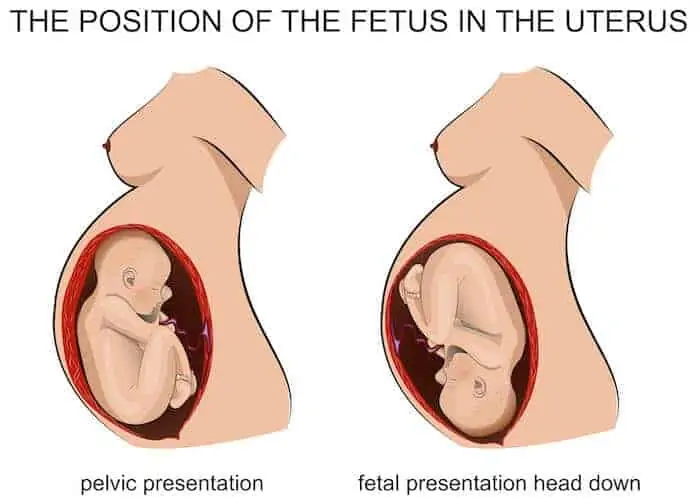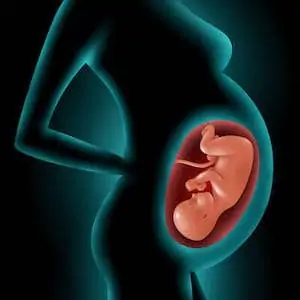After almost 9 months of increasing discomfort, you’re getting into the home stretch as you near that due date. As you’ve gotten up to this point, you’ve probably felt your baby move and kick quite a bit. Both of mine were apparently doing gymnastics.
In any event, as your baby nears the time for birth, he’s got much less room to work with for his daily acrobatics. The position he ends up in is extremely important for your labor and delivery, which is exactly why your doctor makes you turn up for appointments weekly during this time.
While checking everything else, he or she will assess your baby’s position. They’ve done this for you before, but it’s one of the most important things to know in the last month. If your baby isn’t in the right position, you can do a few things (which I’ll discuss below) to coax him around. But if that doesn’t work, you may need to plan on a different type of delivery.

For my first, everything was going fine right up until my water broke. Gushed is more like it. Once I got to the hospital, I was constantly monitored. She was fine and had her head down at that point, but I wasn’t dilated enough to go into the delivery room.
About 18 hours later, I was finally ready to deliver this kid. We got to the delivery room, I got an epidural, and about 10 minutes later, I still felt excruciating pain. Turns out, she turned around inside of me. She was now head-butting my lower back. We tried to get her to turn, but I couldn’t handle it anymore between the pain and my exhaustion. We had to go with an emergency c-section after that, tossing my pristine birth plans right out the window.
I’m not telling you this to freak you out but rather so you know that you have to go with the flow sometimes and just do what’s best in your situation. Sometimes, everything will go according to plan, and other times, like in my situation, it won’t.
Possible Positions of Your Baby
During that last month, your doctor will use some lingo to describe your baby’s position. Let’s talk about that:
Anterior
If your baby is in this position, that’s great news. It’s the safest and most ideal position for delivery. This is when your baby is head down, and their face is toward your back. With their chin tucked down into their chest, they are ready for the journey through the birth canal.
If your doctor says “occiput-anterior,” this is also good. It’s when your baby can flex their head and neck and get into position. For the anterior position, your baby’s head can press on your cervix, helping it to open during delivery.
Generally, most babies get into this position between weeks 33 and 36.
Posterior
In this position, your baby’s head is facing down. However, their face is turned toward your stomach. Called the occiput-posterior, you shouldn’t worry if your baby is in this position. Most of the time, your baby will turn on their own to face the right direction before you give birth.
Sometimes though, your baby won’t rotate, and you’re left to have a longer delivery with extreme back pain. I will say this: there is no shame in having an epidural. NONE. And if you choose to forgo one, there is nothing wrong with that. Do what is best for you and the baby.
Breech
This one is definitely no good, but don’t panic if you hear your doctor tell you this is the position your baby is in. There are 3 types of breech positions:

- Complete breech: Baby’s butt points down to your birth canal while the legs are folded at the knees and feet are close to the butt.
- Frank breech: Baby’s butt also points toward the birth canal, but the legs are straight in front of the body, with feet by the head.
- Footling breech: Either one or both feet point downward in the birth canal direction.
You definitely don’t want your baby in this position because it makes it harder to deliver vaginally. You can still try, but there’s more risk to the baby and you too. It also increases the risk that the umbilical cord can loop around your baby’s neck.
If your baby is in any type of breech position, your doctor will lay out all the options for getting them into a head-down position. There’s a technique known as an ECV or external cephalic version. This is when pressure is applied to your abdomen. It’s very uncomfortable, but it is very safe. Often, it is quite effective in getting the desired result.
But sometimes, it’s not, especially if your baby is trying to come into the world feet-first. In those cases, a c-section is pretty much a sure thing.
Transverse lie
There is one more position that most people don’t know about because it’s so rare for a baby to be in at the time of delivery. If your baby is in the transverse lie when you go into labor, you will have no choice but to have a c-section. The risk of the umbilical cord coming out before your baby when your water breaks is far too great and must be taken care of urgently.
You don’t need to wait until your next ultrasound to find out what position your baby is in. You can just try out a little technique known as belly mapping.
The Art of Belly Mapping
This technique is something you can do around your 8th month. You just need a washable marker (non-toxic) or even body paint (again, non-toxic), a fetoscope, and a doll as a prop. Try it out right after you visit your doctor so you know where the head is.
Then, follow these steps to belly mapping, which you can do any time to get peace of mind.
- Lie down on your back
Your bed is a good place. Lie down and put very gentle pressure around your pelvis to feel for the head. You’ll know you’ve found it when you feel something like a bowling ball (but smaller, of course). Make a mark on your belly where you felt it.
- Use the fetoscope
You’ll listen for your baby’s heart with the fetoscope and mark that on your belly too. Don’t have a fetoscope? Then pay close attention to your ultrasound and take notes where your doctor found the heartbeat. You can mark it later when you’re home.
- Use the doll
This is where you’ll entertain the positions based on the position of your baby’s heart and head.
- Find the butt
It’s hard and round but not like the head. If you’ve found the head, go the opposite way for your baby’s butt, and you should find it. Again, mark it.
- Use kicking as cues
Another way to find your baby’s position is to pay attention to how they’re moving, particularly where those kicks land. This will help you figure out where the knees or legs are so you can mark them.
Once you know all these things, you can draw the baby on your belly, something fun that’s great for your baby shower or even with your spouse. Some women get super creative with it.
Other Ways to Tell if Baby’s Head is Down
You can also do some other detective work to figure out if your baby’s head is down:
- Listen for hiccups. The baby’s head is down if you feel them lower in your belly.
- If the kicks feel high up, the head is likely down.
- If you feel fluttery feelings lower down, it’s your baby’s hands which is another sign of the head being down.
Generally, your baby’s head might be there if you start feeling extreme pain near or under your ribs. You can use baby mapping techniques to feel for the head. While the butt is also round, it’s soft so you can tell a distinctive difference between each end.
What to Do to Get Baby’s Head Down
If you’re in your last month of pregnancy and your baby’s head isn’t down, and in occiput-anterior, you can try to coax her into the right position. Your doctor may suggest you try the following things:
- Sit and tilt your pelvis forward.
- Sit on an exercise ball (like the one you bought to get in shape with that sits in the corner of your garage).
- Keep your hips higher than your knees every time you sit.
- If you often sit, like at the office, get up and move around.
- While in the car, try adding a cushion to help you tilt your pelvis forward.
- Get on your hands and knees like a dog several times a day. Barking optional.
Whatever you do, don’t squat. If your baby is in the wrong position, this will just lodge them deeper into it, dropping them down (also known as lightening), making it more difficult to get them turned to the right position.
It’s certainly worth trying those techniques out, though be forewarned that they might not work. The shape of your pelvis is another factor that could make it difficult for your baby to turn into the best position for delivery. You may be discussing the possibility of a c-section with your doctor for that.
You can also head in for a prenatal massage or chiropractic treatment. Just ask your doctor what they think is best.
One Last Bit of Advice

It’s totally normal for your baby to turn and move a lot during your pregnancy. You’ll feel this movement in the middle of your second trimester on to the end. As they run out of room in your womb, the feeling is more squirmy than anything.
Once they settle into a position, by week 36, you should be concerned about which way they’re facing. Up until that point, try to relax and not stress. Stress will make things worse for you and the baby.
My mom always says, “It is what it is,” so do everything you can to sit right, relax, eat well, and enjoy yourself. Your OB/GYN will help you sort out any problems that may arise.
If you’re worried about your baby’s position as you get into the final weeks, make a back-up birth plan with your doctor that includes the possibility for a c-section. It’s nothing to be afraid of (I’ve had two of them!) but knowing what to expect will make it less chaotic and stressful for you should there be no other alternative.
I only wish I’d thought beyond what I wanted when I was going in for delivery. I imagined my birth experience with an epidural and pushing her out vaginally. It couldn’t have been beyond my expectations, but my doctor and her team took excellent care of us.
The result was beyond my expectations, though, having a sweet precious daughter that would turn me into a mom. Focus on that, and you’ll get through whatever type of delivery is coming your way.
Leslie Berry lives with her husband and two young daughters in Los Altos, California, where she loves helping other moms get comfortable with motherhood and embracing the insanity with facts peppered with laughs.
She loves eating too much sushi, exercising, and jamming out on her Fender. Read more about Leslie here.






